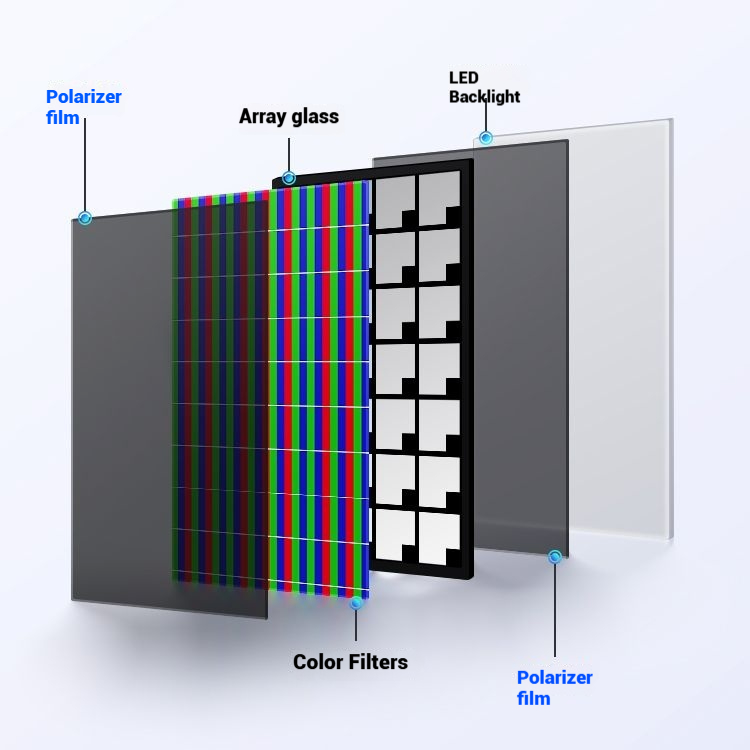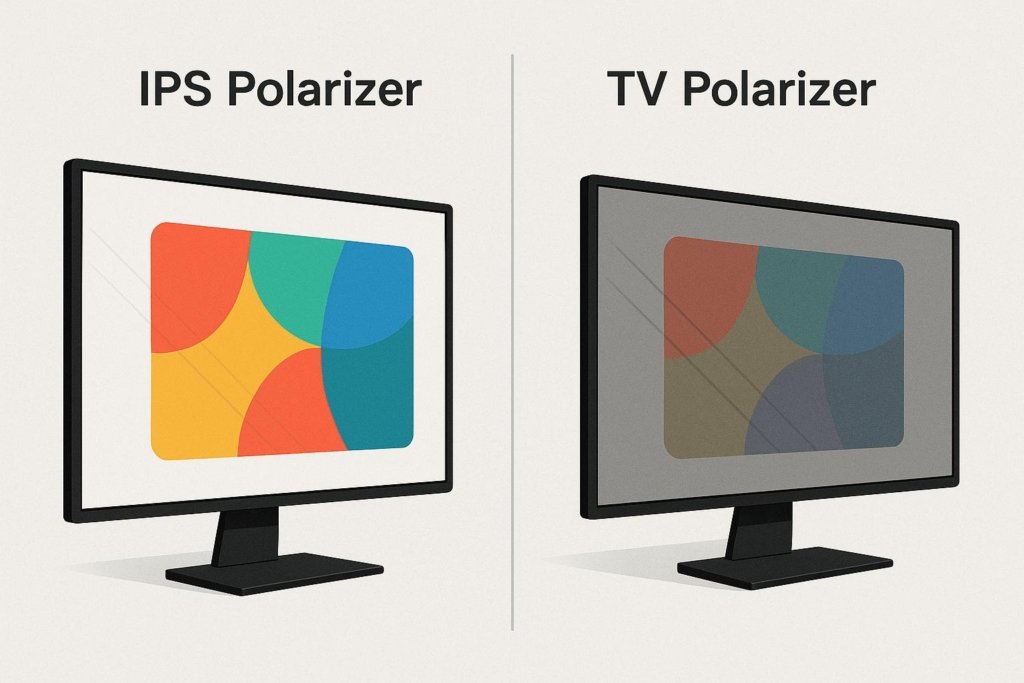What is filme polarizador?
A polarizing film is an optical material that selectively transmits or blocks light waves of a specific direction. It alters the properties of light by adjusting the direction of its vibration. Polarizing films are commonly used in devices such as sunglasses, photographic filters, and liquid crystal displays. We can see the position of the polarizing film in the LED backlight as below.

The main differences between IPS and TV polarizers are as follows:
Representative Examples of Conventional Transmissive Polarizing Film:
IPS(In-Plane Switching): Full-view angle polarizing film, characterized by “thinness” and “ultra-high contrast,” primarily used in smartphones, LCD screens, and high-end display applications. Priced higher, the market primarily consists of finished films;
TV: Near-full-view angle polarizing film, characterized by “thinness” and “high contrast,” with a slightly narrower viewing angle than IPS and slightly inferior display performance compared to IPS, primarily used in television display applications. Priced lower, the market primarily consists of large sheets for cutting.
EWV: Ultra-wide-angle polarizing film, characterized by its “thickness,” can be understood as a thicker version of IPS, with a viewing angle smaller than both IPS and TV, primarily used in automotive display applications. It is expensive, and the market primarily consists of medium and small sizes.
Comparison Table: IPS vs TV Polarizer
| Category | IPS Polarizer Film | TV Polarizer Film |
| Representative Type | Full-view angle polarizer; known for “thinness” and “ultra-high contrast” | Near full-view angle polarizer; known for “thinness” and “high contrast” |
| Viewing Angle | Up to 170°–180°; consistent color and brightness from all directions | Around 160°; slight color and brightness shifts at non-frontal angles |
| Contraste | Ultra-high contrast; deeper blacks, brighter whites, richer color gradients | Lower contrast; blacks appear lighter, whites less bright, colors less saturated |
| Application Areas | High-end displays: smartphones, laptops, premium TVs | General TV displays, large monitors, advertising screens |
| Price | Higher; complex production process and stricter material requirements | Lower; simpler manufacturing and lower material costs |
| Market Form | Primarily supplied as finished films to display manufacturers | Sold in large sheets for cutting to fit various screen sizes |
| Other Types | EWV: Extra-wide-view type; thicker, slightly narrower angle, used in automotive displays | / |
Viewing angle
IPS polarizer film: These are full-viewing-angle polarizers with a viewing angle of up to 170 degrees to nearly 180 degrees. When viewed from any direction, the color, brightness, and other display effects of the screen remain consistent, with no significant differences in viewing angle or display quality.
TV polarizer film: This is a near-wide-viewing-angle polarizing film with a slightly narrower viewing angle than IPS. Typically, the vertical and horizontal viewing angles reach around 160 degrees. When viewed from the side or other non-frontal angles, the color, brightness, and other display effects of the image may undergo some changes.
Contraste
IPS polarizer film: It features ultra-high contrast, enabling more distinct black-and-white contrast and richer color gradients, resulting in clearer image details and more vibrant colors.
TV Polarizer Film: Has relatively lower contrast than IPS. While it can meet general display requirements, when displaying black and white, the black may not be as deep and the white may not be as bright as IPS, and the color layers and saturation are also slightly inferior.

Application Areas
IPS Polarizing Film: Due to its advantages such as wide viewing angles and high contrast, it is commonly used in high-end electronic display fields, such as smartphones, laptops, and high-end televisions, where display quality is critical.
TV Polarizing Film: Primarily used in general electronic television fields, it is also commonly used in devices that require large display sizes but do not demand exceptionally high display quality, such as large monitors and advertising screens.
Price
IPS Polarizing Film: The production process is relatively complex, with high requirements for materials and manufacturing technology, so the price is generally higher.
TV Polarizing Film: The production process is relatively simple, with lower costs, so the price is also relatively affordable.
Market Form
IPS Polarizing Film: The market primarily consists of finished films, directly supplied to manufacturers of high-end display devices.
TV Polarizing Film: The market primarily consists of large sheets, which are cut to size for use in various TV screen sizes and other products.
 Soluções de luz de fundo personalizadas & Fornecedor de folhas ópticas – Rnoda Tech
Soluções de luz de fundo personalizadas & Fornecedor de folhas ópticas – Rnoda Tech

